James Rosenquist Prints
Florida Gulf Coast University’s permanent art collection includes three works by pop artist James Rosenquist. Located in the North-South Corridor of the Campus Support Complex, one is a 1972 trial proof titled Pulling Out and the other two are 1974 embossed prints titled Time Flowers and Spikes.
About James Rosenquist
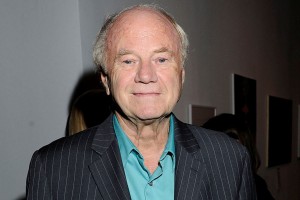 Born in 1933 in Grand Forks, North Dakota, James Rosenquist studied art at the Minneapolis Institute of Arts as a teenager and at the University of Minnesota between 1952 and 1954, painting billboards during the summers. In 1955 he moved to New York to study abstract expressionism at the Art Students League. But he rejected the genre and left the school after one year, returning in 1957 to
Born in 1933 in Grand Forks, North Dakota, James Rosenquist studied art at the Minneapolis Institute of Arts as a teenager and at the University of Minnesota between 1952 and 1954, painting billboards during the summers. In 1955 he moved to New York to study abstract expressionism at the Art Students League. But he rejected the genre and left the school after one year, returning in 1957 to 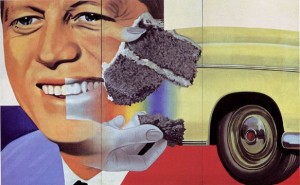 life as a commercial artist, painting billboards in Times Square and across the city. As it turned out, this proved to be perfect training for Rosenquist’s unique brand of pop art. Rosenquist deftly applied the sign-painting techniques he’d learned to the large-scale paintings he began creating in 1960 such as such as President Elect, a 2.13 x 3.66
life as a commercial artist, painting billboards in Times Square and across the city. As it turned out, this proved to be perfect training for Rosenquist’s unique brand of pop art. Rosenquist deftly applied the sign-painting techniques he’d learned to the large-scale paintings he began creating in 1960 such as such as President Elect, a 2.13 x 3.66 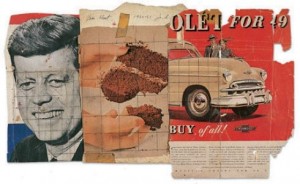 meter oil on masonite in which the glamorous face of John F. Kennedy is combined with the side of a 1950s car and a hand holding a piece of cake painted in grey as if it were a black-and-white photograph.
meter oil on masonite in which the glamorous face of John F. Kennedy is combined with the side of a 1950s car and a hand holding a piece of cake painted in grey as if it were a black-and-white photograph.
Like his contemporaries in the pop scene, Rosenquist adapted the visual language of 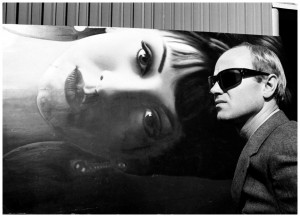 advertising and pop culture (often funny, vulgar, and outrageous) to the context of fine art. But his references to mass-produced goods and to magazines, films and other aspects of the mass media, together with his dispassionate and seemingly anonymous technique, propelled him to stardom in the developing pop art movement in the USA. According to Oxford Press’ Marco
advertising and pop culture (often funny, vulgar, and outrageous) to the context of fine art. But his references to mass-produced goods and to magazines, films and other aspects of the mass media, together with his dispassionate and seemingly anonymous technique, propelled him to stardom in the developing pop art movement in the USA. According to Oxford Press’ Marco 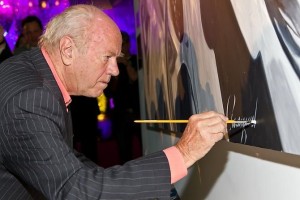 Livingstone, “Rosenquist’s treatment of typical Pop subject-matter such as sex and consumerism had little in common with the directness and immediacy of work by such artists as Andy Warhol and Roy Lichtenstein; rather than seeking to duplicate his source material, he preferred to impose himself on it through procedures of disruption and dislocation, as in Marilyn Monroe
Livingstone, “Rosenquist’s treatment of typical Pop subject-matter such as sex and consumerism had little in common with the directness and immediacy of work by such artists as Andy Warhol and Roy Lichtenstein; rather than seeking to duplicate his source material, he preferred to impose himself on it through procedures of disruption and dislocation, as in Marilyn Monroe 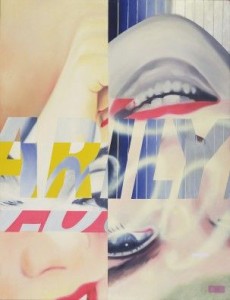 I (oil and spray enamel on canvas, 2.36×1.84 m, 1962; New York, MOMA), in which the film star’s features are presented in a dismembered form as if to imply that her personality had been shattered by the pressures of fame.”
I (oil and spray enamel on canvas, 2.36×1.84 m, 1962; New York, MOMA), in which the film star’s features are presented in a dismembered form as if to imply that her personality had been shattered by the pressures of fame.”
Rosenquist was also unusual among pop artists in his overt involvement with political themes in works such as Painting for the American Negro. But it was his 1964 painting F-111 that first brought him international acclaim. Rosenquist painted the 9-foot tall by 86-foot-long F-111 in the middle of one of this country’s most turbulent decades. Inspired by advertising billboards and by earlier mural-scaled paintings such as Claude Monet’s Water 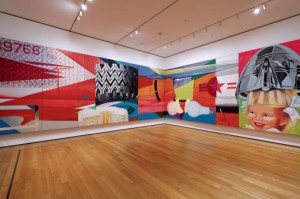 Lilies, he designed its interconnected 51 panels to wrap around the four walls of the Leo Castelli Gallery at 4 East 77th Street in Manhattan, where it would be displayed the following year. Rosenquist took as his subject the F-111 fighter bomber plane, the newest, most technologically advanced weapon in development at the time, and positioned it, as he later explained, “flying through
Lilies, he designed its interconnected 51 panels to wrap around the four walls of the Leo Castelli Gallery at 4 East 77th Street in Manhattan, where it would be displayed the following year. Rosenquist took as his subject the F-111 fighter bomber plane, the newest, most technologically advanced weapon in development at the time, and positioned it, as he later explained, “flying through 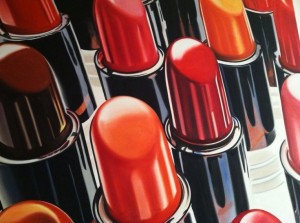 the flak of consumer society to question the collusion between the Vietnam death machine, consumerism, the media, and advertising.”
the flak of consumer society to question the collusion between the Vietnam death machine, consumerism, the media, and advertising.”
Through a complex layering of such motifs as Coca-Cola bottles, kitchen appliances, packaged foods, and women’s lipsticked mouths and manicured hands, Rosenquist’s large canvases and prints embody and comment on the dizzying 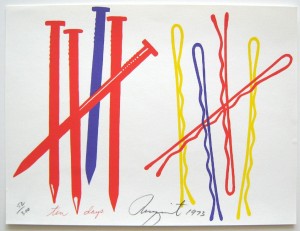 omnipresence of the consumer world. In addition to painting, he has produced a vast array of prints, drawings, and collages; his print Time Dust (1992) is thought to be the largest print in the world, measuring seven by thirty-five feet.
omnipresence of the consumer world. In addition to painting, he has produced a vast array of prints, drawings, and collages; his print Time Dust (1992) is thought to be the largest print in the world, measuring seven by thirty-five feet.
The artist has received numerous honors. He was selected as the Art in America Young Talent Painter in 1963, appointed to a six-year term on 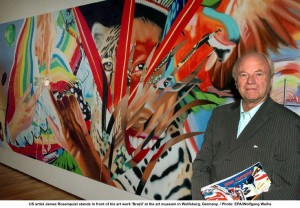 the Board of the National Council on the Arts in 1978, and nominated as a member of the American Academy and Institute of Arts and Letters in 1987. Since his first early career retrospectives in 1972, organized by the Whitney Museum of American Art and the Wallraf-Richartz-Museum, Cologne, he has been the subject of gallery and museum exhibitions in the U.S. and internationally. But
the Board of the National Council on the Arts in 1978, and nominated as a member of the American Academy and Institute of Arts and Letters in 1987. Since his first early career retrospectives in 1972, organized by the Whitney Museum of American Art and the Wallraf-Richartz-Museum, Cologne, he has been the subject of gallery and museum exhibitions in the U.S. and internationally. But 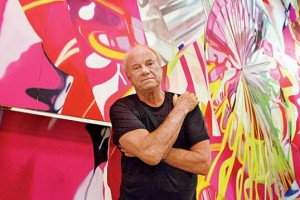 while Rosenquist is widely regarded as one of the leaders of Pop art, he detested the label, saying “What united us [referring to Andy Warhol, Roy Lichtenstein, Claes Oldenburg, and Tom Wesselmann], you might say, was dread of the drip, the splash, the schmear, combined with an ironic attitude toward the banalities of American consumer culture. If anything, you might say we were antipop artists.”
while Rosenquist is widely regarded as one of the leaders of Pop art, he detested the label, saying “What united us [referring to Andy Warhol, Roy Lichtenstein, Claes Oldenburg, and Tom Wesselmann], you might say, was dread of the drip, the splash, the schmear, combined with an ironic attitude toward the banalities of American consumer culture. If anything, you might say we were antipop artists.”














 Tom Hall is both an amateur artist and aspiring novelist who writes art quest thrillers. He is in the final stages of completing his debut novel titled "Art Detective," a story that fictionalizes the discovery of the fabled billion-dollar Impressionist collection of Parisian art dealer Josse Bernheim-Jeune, thought by many to have perished during World War II when the collection's hiding place, Castle de Rastignac in southern France, was destroyed by the Wehrmacht in reprisal for attacks made by members of the Resistance operating in the area. A former tax attorney, Tom holds a bachelor's degree as well as both a juris doctorate and masters of laws in taxation from the University of Florida. Tom lives in Estero, Florida with his fiancee, Connie, and their four cats.
Tom Hall is both an amateur artist and aspiring novelist who writes art quest thrillers. He is in the final stages of completing his debut novel titled "Art Detective," a story that fictionalizes the discovery of the fabled billion-dollar Impressionist collection of Parisian art dealer Josse Bernheim-Jeune, thought by many to have perished during World War II when the collection's hiding place, Castle de Rastignac in southern France, was destroyed by the Wehrmacht in reprisal for attacks made by members of the Resistance operating in the area. A former tax attorney, Tom holds a bachelor's degree as well as both a juris doctorate and masters of laws in taxation from the University of Florida. Tom lives in Estero, Florida with his fiancee, Connie, and their four cats.